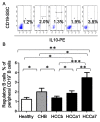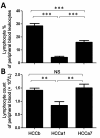Perioperative dynamic alterations in peripheral regulatory T and B cells in patients with hepatocellular carcinoma
- PMID: 22272696
- PMCID: PMC3292477
- DOI: 10.1186/1479-5876-10-14
Perioperative dynamic alterations in peripheral regulatory T and B cells in patients with hepatocellular carcinoma
Abstract
Background: Intratumoral and circulating regulatory T cells (Tregs) have been shown to be critical in the pathogenesis of hepatocellular carcinoma (HCC). However there is limited knowledge on the alterations of regulatory B cells (Bregs). We here investigated perioperative dynamic alterations of peripheral circulating Tregs and Bregs in HCC patients to reveal the relationship between regulatory lymphocytes and its clinical implications.
Methods: 36 patients with HCC, 6 with chronic hepatitis B infection and 10 healthy donors were enrolled for this study. Frequencies of peripheral Tregs and Bregs were measured by flow cytometry with antibodies against CD4, CD25, CD127, CD19 and IL-10 before, and after radical surgery. Then, clinical informatics of HCC patients was achieved through Digital Evaluation Score System (DESS) for the assessment of disease severity. Finally, we analysed correlations between digitalized clinical features and kinetics of circulating regulatory lymphocytes.
Results: Level of circulating CD4+CD25+CD127- Tregs in HCC patients was significantly lower than that in healthy donors and patients with chronic hepatitis B infection before surgery, but was increased after surgery. Preoperative level of CD19+ IL-10+ Bregs in HCC patients was also significantly lower than the other groups. However it dramatically was elevated right after surgery and remained elevated compared to controls (about 7 days after surgery, P = 0.04). Frequency of circulating Tregs was correlated with circulating leukocytes, ferritin, and clinical features suggesting tumor aggressiveness including portal vein thrombosis, hepatic vein involvement and advanced clinical stages. Frequency of circulating Bregs was associated with Hepatitis B e Antigen (HBeAg) and Hepatitis B virus (HBV) DNA copy number. In addition, DESS was significantly and positively correlated with other staging systems.
Conclusion: Frequencies of peripheral Tregs and Bregs in HCC patients increased after surgery. These results suggest that a postoperative combination of therapies against Tregs and Bregs may be beneficial for better outcome of HCC patients after resection.
Figures



Similar articles
-
IL-10-producing regulatory B-cells suppressed effector T-cells but enhanced regulatory T-cells in chronic HBV infection.Clin Sci (Lond). 2016 Jun 1;130(11):907-19. doi: 10.1042/CS20160069. Epub 2016 Mar 15. Clin Sci (Lond). 2016. PMID: 26980345
-
CD4+CD25+CD127-Foxp3+ and CD8+CD28- Tregs in Renal Transplant Recipients: Phenotypic Patterns, Association With Immunosuppressive Drugs, and Interaction With Effector CD8+ T Cells and CD19+IL-10+ Bregs.Front Immunol. 2021 Jul 15;12:716559. doi: 10.3389/fimmu.2021.716559. eCollection 2021. Front Immunol. 2021. PMID: 34335631 Free PMC article.
-
Regulatory T cells in chronic hepatitis B patients affect the immunopathogenesis of hepatocellular carcinoma by suppressing the anti-tumour immune responses.J Viral Hepat. 2010 Mar;17 Suppl 1:34-43. doi: 10.1111/j.1365-2893.2010.01269.x. J Viral Hepat. 2010. PMID: 20586932
-
Immune Regulation by T Regulatory Cells in Hepatitis B Virus-Related Inflammation and Cancer.Scand J Immunol. 2017 Mar;85(3):175-181. doi: 10.1111/sji.12524. Scand J Immunol. 2017. PMID: 28109025 Review.
-
Roles of Tregs in development of hepatocellular carcinoma: a meta-analysis.World J Gastroenterol. 2014 Jun 28;20(24):7971-8. doi: 10.3748/wjg.v20.i24.7971. World J Gastroenterol. 2014. PMID: 24976734 Free PMC article. Review.
Cited by
-
Dynamics of Peripheral Blood Immune Cells during the Perioperative Period after Digestive System Resections: A Systematic Analysis of the Literature.J Clin Med. 2023 Jan 16;12(2):718. doi: 10.3390/jcm12020718. J Clin Med. 2023. PMID: 36675647 Free PMC article.
-
Perioperative predictors of outcome of hepatectomy for HBV-related hepatocellular carcinoma.Front Oncol. 2023 Jul 13;13:1230164. doi: 10.3389/fonc.2023.1230164. eCollection 2023. Front Oncol. 2023. PMID: 37519791 Free PMC article. Review.
-
Levels and Clinical Significance of Regulatory B Cells and T Cells in Acute Myeloid Leukemia.Biomed Res Int. 2020 Oct 6;2020:7023168. doi: 10.1155/2020/7023168. eCollection 2020. Biomed Res Int. 2020. PMID: 33083479 Free PMC article.
-
Role of Immune Cells in Patients with Hepatitis B Virus-Related Hepatocellular Carcinoma.Int J Mol Sci. 2021 Jul 27;22(15):8011. doi: 10.3390/ijms22158011. Int J Mol Sci. 2021. PMID: 34360777 Free PMC article. Review.
-
Cellular based immunotherapy for primary liver cancer.J Exp Clin Cancer Res. 2021 Aug 9;40(1):250. doi: 10.1186/s13046-021-02030-5. J Exp Clin Cancer Res. 2021. PMID: 34372912 Free PMC article. Review.
References
-
- Nishikawa H, Sakaguchi S. Regulatory T cells in tumor immunity. Int J Cancer. 2010;127:759–767. - PubMed
-
- Chen KJ, Zhou L, Xie HY, Ahmed TE, Feng XW, Zheng SS. Intratumoral regulatory T cells alone or in combination with cytotoxic T cells predict prognosis of hepatocellular carcinoma after resection. Med Oncol. 2011. - PubMed
-
- Lee WC, Wu TJ, Chou HS, Yu MC, Hsu PY, Hsu HY, Wang CC. The impact of CD4(+)CD25(+) T cells in the tumor microenvironment of hepatocellular carcinoma. Surgery. 2011. - PubMed
Publication types
MeSH terms
LinkOut - more resources
Full Text Sources
Medical
Research Materials

